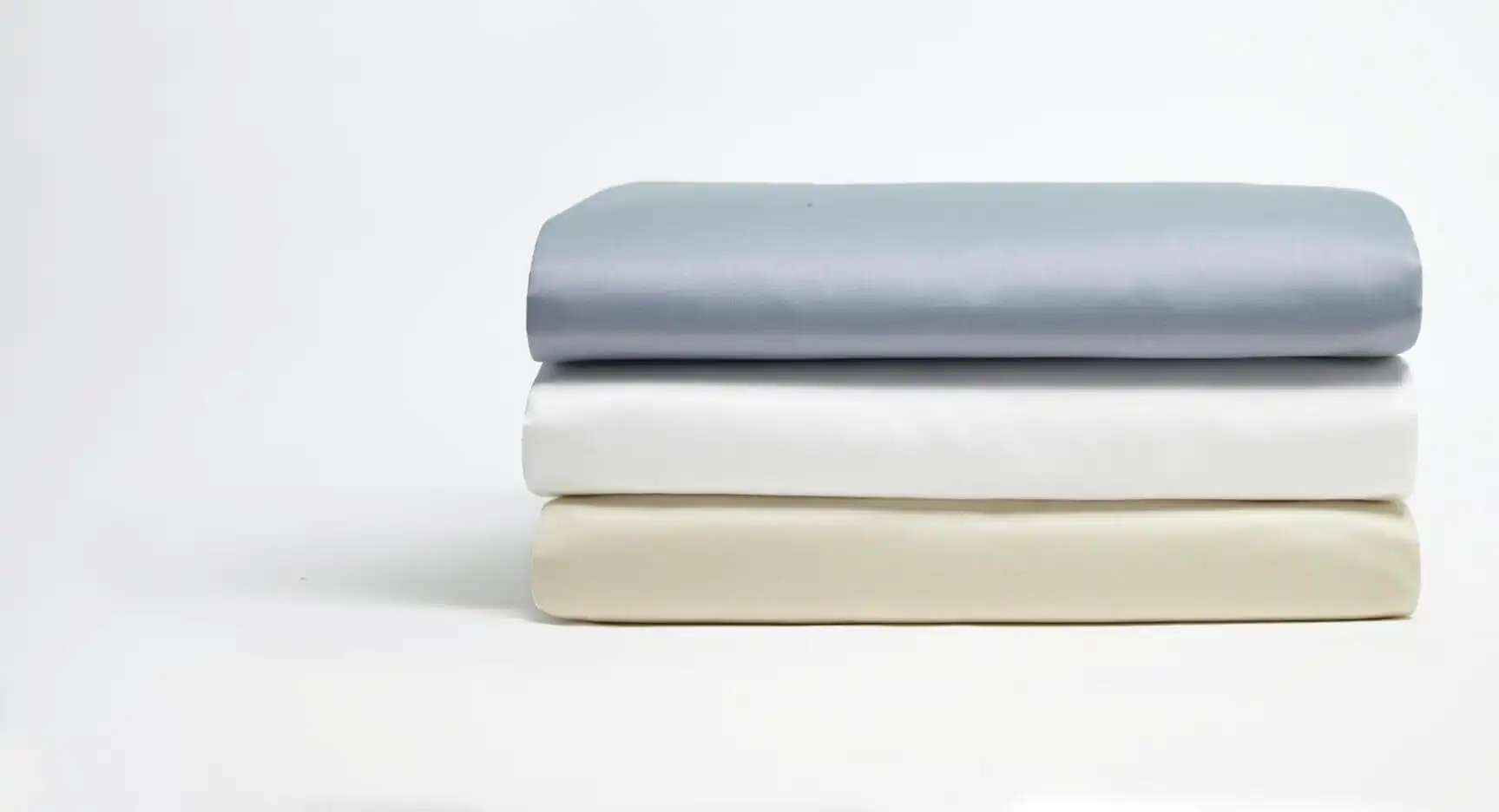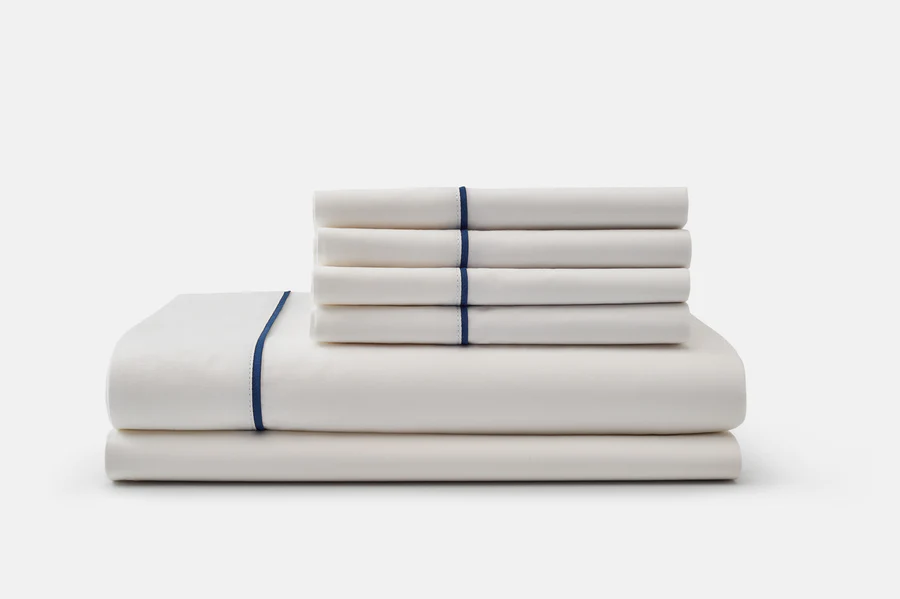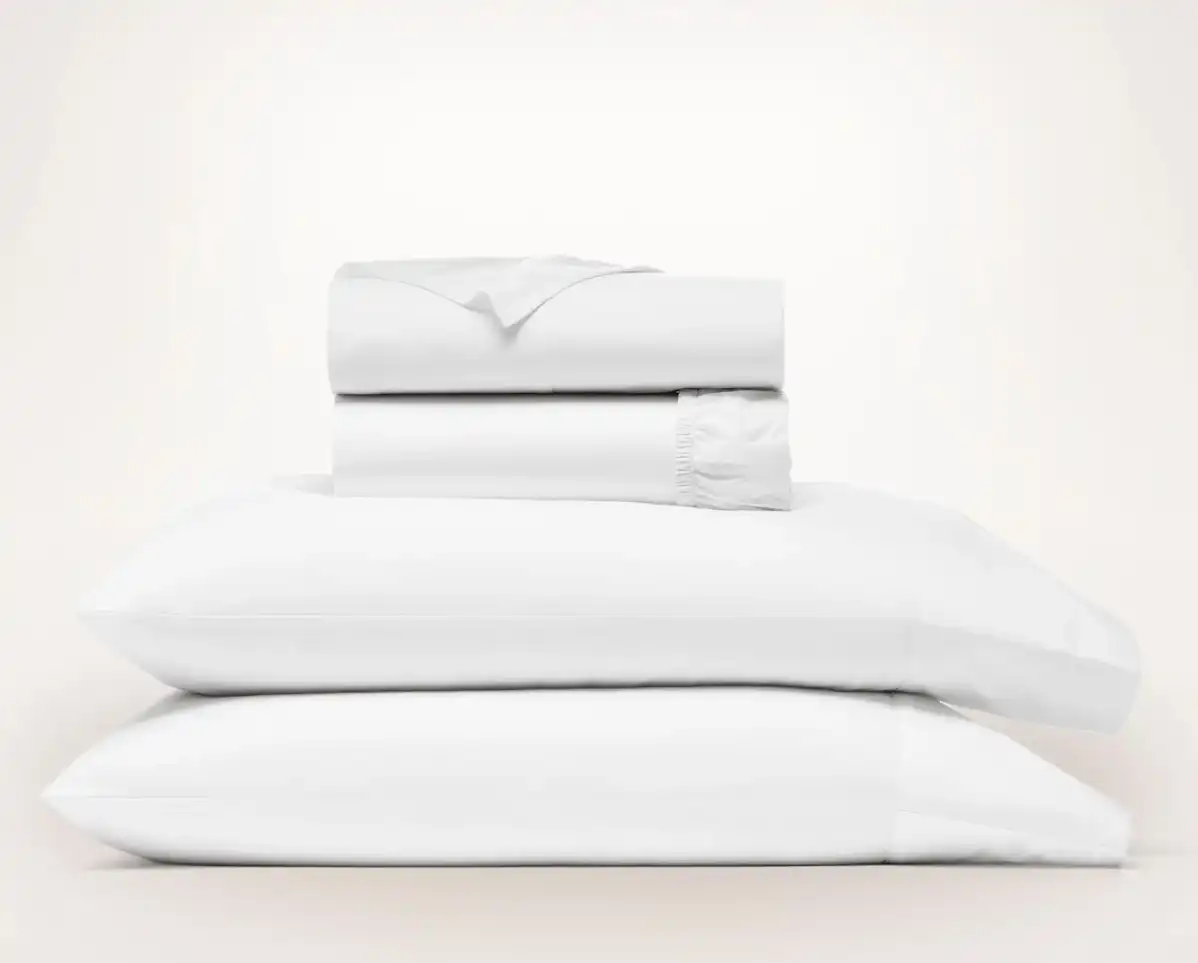Organic Sheets
Below are reviews of some of the best organic sheets in the market. Some of the benefits of organic bed sheets are that the fiber is more durable due to the fact that it isn’t weakened by pesticides. The regular textile industry is a dirty industry that is one of the most chemically intensive crops on the planet. But, it doesn’t have to be that way. There are some great brands that are making organic cotton bedding accessible to everyone.
Are There Organic Sheets that Are Not Cotton?
There are a number of organic bedding options that are not cotton. Some popular choices include:
- Bamboo: Bamboo is a fast-growing and sustainable resource that can be used to make soft and breathable bedding. Bamboo bedding is also hypoallergenic and moisture-wicking, making it a good choice for people with sensitive skin or allergies.
- Linen: Linen is a strong and durable fabric that is made from the flax plant. Linen bedding is naturally cool and breathable, making it a good choice for hot sleepers. Linen is also hypoallergenic and antibacterial.
- Hemp: Hemp is another fast-growing and sustainable resource that can be used to make bedding. Hemp bedding is soft and absorbent, and it is also hypoallergenic and odor-resistant.
- Tencel: Tencel is a semi-synthetic fabric that is made from wood pulp. Tencel bedding is soft and silky, and it is also moisture-wicking and wrinkle-resistant. Tencel is also produced in a sustainable way, using closed-loop manufacturing processes.
In addition to these materials, there are also a number of organic bedding brands that offer a variety of unique and innovative materials, such as kapok, eucalyptus, and even wool.
When choosing organic bedding, it is important to look for products that are certified by a reputable organization, such as the Global Organic Textile Standard (GOTS). This will ensure that the bedding is made with organic materials and that it has been produced in a sustainable way.
|
||
|
||
|
||
|
The journey of organic cotton from its inception to becoming a coveted fabric worldwide is both intriguing and emblematic of a larger global shift towards sustainability. With its roots firmly planted in traditional agricultural practices, organic cotton’s rise to prominence offers a compelling narrative of environmental consciousness and global collaboration.
The Genesis of Organic Cotton
The term “organic cotton” might sound contemporary, but in reality, the principles behind it trace back thousands of years. Before the onset of the industrial revolution and the advent of synthetic pesticides and fertilizers in the 20th century, all cotton was, by default, organic. Traditional farming methods relied on natural processes, emphasizing crop rotation, manual pest control, and composting.
The Shift to Conventional Cotton
The post-World War II era witnessed a seismic shift in agricultural practices. Driven by the quest for higher yields and spurred by technological advancements, the cotton industry, like many others, became heavily reliant on synthetic pesticides, herbicides, and genetically modified seeds. This shift dramatically increased cotton production but came at a severe environmental cost, including soil degradation, water pollution, and a reduction in biodiversity.
The Renaissance of Organic Cotton
By the late 20th century, the repercussions of these aggressive farming practices became increasingly evident. The 1980s and 1990s saw a burgeoning environmental movement, leading to a renewed interest in organic agriculture. Organic cotton emerged as a response to the environmental and health concerns associated with conventional cotton farming. Early adopters faced challenges, from seed acquisition to navigating a market dominated by cheaper conventional cotton. However, buoyed by growing consumer awareness and demand for eco-friendly products, organic cotton gradually regained its footing.
Global Production: Who’s Leading the Way?
Today, organic cotton is grown in numerous countries, but a few stand out in terms of volume and influence:
India: Historically a major player in the cotton industry, India has embraced organic cotton production with zeal. Leading the world in organic cotton production, the country benefits from traditional farming knowledge and a vast agricultural landscape.
China: As one of the world’s textile giants, China’s foray into organic cotton production is significant. With increasing domestic demand for organic products and a vast export market, China is rapidly expanding its organic cotton farms.
Turkey: Renowned for its high-quality textiles, Turkey has seamlessly integrated organic cotton into its production chain. The country’s Mediterranean climate proves favorable for cultivating this eco-friendly crop.
United States: Although the U.S. was late to join the organic cotton movement, certain states, particularly Texas, have seen a rise in organic cotton farms, catering both to domestic and international markets.
The tale of organic cotton is one of resilience, adaptability, and foresight. From its ancient origins to its modern resurgence, organic cotton represents humanity’s capacity to evolve and make choices that benefit both the individual and the planet. As global production surges, spearheaded by nations with a vision for a sustainable future, organic cotton stands not just as a fabric but as a testament to eco-conscious living.
Chemical Profiles: Regular Sheets vs. Organic Cotton Sheets
The textile industry, with its vast array of fabrics and finishes, often employs a cocktail of chemicals in the production process. This is especially true for bedding, where the comfort, look, and feel are paramount for consumers. But what does this mean in terms of chemical exposure when juxtaposing regular sheets with their organic counterparts? Here’s an analytical breakdown.
Regular Sheets
The term “regular sheets” typically refers to conventionally grown cotton sheets or those made from synthetic fibers. The production of these sheets can involve a plethora of chemicals:
Pesticides and Herbicides: Conventionally grown cotton utilizes a significant amount of chemical pesticides and herbicides to fend off pests and weeds, making it one of the most chemically intensive crops.
Dyes: Conventional sheets often employ synthetic dyes, which can contain harmful chemicals and heavy metals.
Bleaching Agents: To achieve the pristine white hue many consumers desire, sheets often undergo a bleaching process which involves chemicals like chlorine or hydrogen peroxide.
Chemical Finishes: These are applied to give sheets specific qualities:
- Formaldehyde: Used to make sheets wrinkle-free.
- Perfluorinated chemicals (PFCs): For water and stain resistance.
- Antimony: Common in polyester as a catalyst.
Softeners and Brighteners: To enhance the feel and appearance of sheets, chemical softeners and optical brighteners might be used, which can remain as residues.
Organic Cotton Sheets
Organic cotton sheets, on the other hand, are manufactured with an emphasis on reducing chemical inputs and ensuring environmental and consumer safety.
Pesticides and Herbicides: Organic cotton is grown without synthetic pesticides and herbicides. Instead, it relies on natural alternatives and traditional farming practices like crop rotation.
Dyes: While not all organic sheets are undyed, those that are colored often use natural or low-impact dyes that are free from harmful toxins and heavy metals.
Bleaching Agents: Many organic sheets are unbleached or use safer alternatives like oxygen-based bleaches.
Chemical Finishes: Genuine organic cotton sheets typically avoid finishes that use harmful chemicals. If they do employ treatments, they’re often water-based or utilize safer compounds.
Softeners and Brighteners: Organic processes often sidestep these chemicals, relying on the natural softness of the cotton and mechanical methods.
While both regular and organic sheets undergo chemical processes, the volume and toxicity of these chemicals differ dramatically. Regular sheets, though often more affordable and diverse in appearance, carry the weight of numerous chemicals that have potential environmental and health ramifications. Organic cotton sheets, in contrast, emphasize minimal chemical intervention, aligning with eco-conscious values and presenting a safer option for skin contact. As consumers become increasingly aware of what goes into their products, the chemical profiles of their bedding choices warrant keen scrutiny.
The Benefits of Organic Sheets and The Importance of Certifications
In a world increasingly concerned with sustainability, personal wellness, and environmental responsibility, organic cotton sheets have risen in prominence. While consumers may initially balk at the price tag compared to conventional options, the benefits of investing in organic sheets, both for individual health and for the planet, are significant.
Organic cotton sheets are crafted from cotton grown without the use of synthetic pesticides, insecticides, or fertilizers. This cultivation process benefits both the environment and the farmers who grow the cotton, safeguarding them from exposure to potentially harmful chemicals. Consumers, in turn, can rest easy knowing their sheets are free from residual chemical substances that could potentially affect their health (Source: Environmental Protection Agency).
Beyond environmental and health advantages, organic sheets also offer an elevated sleeping experience. They are softer, more breathable, and hypoallergenic, providing a clean and comfortable night’s sleep (Source: Sleep Foundation). Furthermore, organic cotton sheets are more durable and tend to last longer than their conventional counterparts due to the integrity of the fibers not being compromised by chemical treatments (Source: Consumer Reports).
Certifications to Look for and Their Meaning
When it comes to purchasing organic sheets, it’s essential to understand the certifications involved. The key certifications to look for include:
Global Organic Textile Standard (GOTS): The most trusted organic textile certification worldwide, GOTS ensures that the entire manufacturing process of the product, from harvest to packaging, is environmentally and socially responsible. Products with a GOTS label must contain at least 70% organic fibers (Source: Global-standard.org).
OEKO-TEX® Standard 100: This certification guarantees that every component of the product has been tested for harmful substances and is therefore harmless in human ecological terms. However, it does not certify the product as organic (Source: Oeko-tex.com).
Fair Trade Certified™: Fair Trade certification confirms that the people involved in the production of the goods were treated ethically and paid fair wages (Source: Fairtrade.net).
Thread Count and Its Significance
While thread count—a measure of the number of threads per square inch of fabric—has often been used as a benchmark of sheet quality, it isn’t always the most reliable indicator. A thread count between 200 and 400 is generally considered ideal for a balance of softness and durability. However, the quality of the fibers and the weave can often be more significant in determining the ultimate comfort and longevity of the sheets (Source: Good Housekeeping).
Market Share of Organic Sheets
As of 2021, the global organic cotton market was valued at approximately $7.58 billion and was forecasted to reach about $15.98 billion by 2027, growing at a CAGR of 12.2% (Source: Allied Market Research). The organic sheet segment forms a substantial portion of this market, driven by increasing consumer awareness of environmental issues, the desire for improved sleep hygiene, and an overall trend towards organic and natural products in the home sector.
While the market share of organic sheets is continually evolving, it’s evident that their benefits—enhanced comfort, improved health and wellness, and reduced environmental impact—are resonating with consumers, leading to a steady rise in popularity. As we all become more conscious consumers, the role of certifications in confirming product authenticity and sustainability will also continue to grow in importance.
Pros and Cons of Organic Cotton Sheets
When it comes to bedding, organic cotton sheets have steadily gained traction among consumers, presenting an eco-friendly alternative to conventional cotton and synthetic bed linens. Like all products, however, organic cotton sheets come with their own set of advantages and drawbacks. This comprehensive analysis delves into the pros and cons of these sheets to provide consumers with a clearer understanding of what they’re investing in.
Pros of Organic Cotton Sheets
Environmentally Friendly: Organic cotton is grown without the use of synthetic pesticides, herbicides, or genetically modified organisms (GMOs). This means that the soil in which it’s cultivated remains healthier and less polluted. Consequently, water sources nearby are spared from contamination.
Health Benefits: For those with sensitive skin or allergies, organic cotton sheets may offer relief. The absence of harmful chemicals and dyes typically means they are less likely to trigger allergies or skin irritations.
Ethical Production: Many organic cotton producers adhere to more humane working conditions, ensuring fair wages and safer working environments. The Global Organic Textile Standard (GOTS) is one of the certifications that mandates not just environmental standards, but also social criteria in textile processing.
Durability: Due to the natural fibers and absence of harsh chemicals, organic cotton sheets often have a longer lifespan than their conventional counterparts. With proper care, they can remain soft and comfortable for years.
Improved Sleep Experience: The natural properties of organic cotton allow it to breathe better, which can help regulate body temperature during sleep. Many users report a crisper, cooler sleep experience with these sheets.
Cons of Organic Cotton Sheets
Higher Initial Cost: Organic cotton products typically come with a heftier price tag compared to conventional cotton sheets. This can be attributed to the more labor-intensive farming practices and the costs associated with obtaining organic certifications.
Availability: While the popularity of organic cotton sheets is on the rise, they might not be as readily available as conventional sheets. Depending on where you live, finding a variety of styles or sizes might be challenging.
Care Requirements: Some organic cotton sheets may have specific care requirements to maintain their integrity and softness. This can mean more time and attention during laundry.
Variability in Standards: Not all “organic” labels are created equal. Depending on the country and certification body, what qualifies as “organic” might vary, leading to potential inconsistencies in product quality.
Appearance: Organic cotton sheets might not always have the polished, ultra-smooth appearance of sheets produced with chemical treatments. For some consumers, this might translate to a perception of lesser luxury or comfort.
How to Make Sure Your Sheets are Actually Organic
In today’s eco-conscious market, the appeal of organic products is undeniable. However, as with any trend, the proliferation of ‘organic’ labels can sometimes blur the lines between genuine and misleading claims. When it comes to bedding, particularly organic cotton sheets, how can consumers ensure they’re getting the real deal? Here’s a comprehensive guide to help you discern the genuinely organic from the merely labeled.
1. Look for Certified Labels
Global Organic Textile Standard (GOTS): Widely recognized as the gold standard in organic textile certification, GOTS ensures that at least 95% of the fabric is organic. Moreover, it enforces environmental and social criteria throughout the entire production process, from harvesting to manufacturing.
Organic Content Standard (OCS): This certification ensures the accurate tracking and management of organic content within textiles.
Always remember: a mere ‘organic’ tag isn’t enough. It’s the certification that offers credibility.
2. Understand Thread Count Misconceptions
A high thread count isn’t always an indicator of quality, especially when it comes to organic sheets. Some manufacturers might use thinner threads to increase the thread count artificially, compromising durability. Instead of fixating on thread count alone, focus on the quality of the fiber and its certification.
3. Research the Brand
In today’s digital age, information is at our fingertips:
- Brand’s Website: Most genuine brands will readily provide detailed information about their sourcing, production process, and certifications.
- Third-party Reviews: Look for reviews on independent platforms. Genuine user reviews often shed light on product authenticity.
- Company Ethics and Transparency: Brands genuinely committed to the organic cause typically have clear ethical policies and transparency reports available to the public.
4. Scrutinize the Fine Print
Labels can sometimes be deceiving. Terms like ‘natural’, ‘green’, or ‘eco-friendly’ don’t necessarily equate to organic. Read the product details thoroughly. For instance, if a label claims “Made with Organic Cotton”, it may only contain a small percentage of organic fibers, with the rest being conventional or synthetic.
5. Check the Price Point
While price shouldn’t be the sole determining factor, it’s a given that genuine organic sheets will generally cost more than their conventional counterparts. This is due to the sustainable and labor-intensive farming practices employed. If a deal seems too good to be true, it just might be.
6. Ask Questions
Don’t hesitate to reach out to the manufacturer or retailer:
- Where is the cotton sourced from?
- Can they provide details on the supply chain?
- Are there any third-party tests or verifications?
Engaging with the brand can provide insights into their commitment to organic practices.
7. Feel and Smell
Genuine organic sheets often feel more breathable and softer over time. Moreover, they shouldn’t have any chemical smell. Conventional sheets, especially those treated with formaldehyde (a common finish to prevent wrinkling), might have a distinct chemical odor.
Things to Consider When Shopping for Organic Sheets
In today’s marketplace, where the green movement intersects with consumer demand, organic sheets have risen from a niche luxury to a mainstream essential. As interest grows, so does the market, making selection a meticulous process. For those looking to invest in organic bedding, here’s a definitive guide on factors to take into account.
1. Certifications
Certifications offer a benchmark of authenticity and quality:
Global Organic Textile Standard (GOTS): This certification ensures that the sheets are made of at least 95% organic fibers and comply with stringent environmental and social standards throughout production.
Organic Content Standard (OCS): It tracks and verifies the presence of organic material in textiles, ensuring credible labeling.
When examining certifications, ensure that the entire product, not just a component, meets the standard.
2. Fiber Quality
The authenticity of organic sheets largely hinges on the quality of its fibers. Look for long-staple or extra-long-staple organic cotton, renowned for its durability, softness, and resistance to pilling.
3. Thread Count
While a common selling point, an extremely high thread count can sometimes be misleading. Rather than focusing solely on thread count, consider the quality and ply of the yarn. A thread count between 200 and 400 often strikes a balance between comfort and durability for organic sheets.
4. Weave Type
The weave affects the feel and appearance of the sheets:
- Percale: A crisp, matte finish with a cool feel, perfect for warmer climates.
- Sateen: A smooth, slightly shiny finish with a soft, warm feel, suitable for cooler temperatures.
5. Dyeing and Finishing Process
The way sheets are dyed and finished can impact their organic integrity:
- Low-impact Dyes: These dyes contain no heavy metals and require less water during the dyeing process.
- No Chemical Finish: Avoid sheets treated with chemical finishes, like formaldehyde, which is used to reduce wrinkles.
6. Brand Transparency
Genuine organic brands often prioritize transparency:
- Supply Chain: Brands should be open about where they source their cotton and how it’s processed.
- Ethical Practices: Consider brands that emphasize fair wages, good working conditions, and sustainable farming practices.
7. Return Policy and Warranties
Given that organic sheets can be an investment, understanding the return policy or any warranties is crucial. This provides a safety net if the sheets don’t meet your expectations.
8. Care Instructions
Organic sheets might have specific care requirements to maintain their quality and longevity. Ensure that you’re willing to follow the care guidelines before making a purchase.
9. Price Point
Authentic organic sheets often come at a premium due to sustainable farming and manufacturing practices. However, view this as a long-term investment in quality, health, and the environment.
10. Personal Preferences
Beyond the technical aspects, personal preferences play a pivotal role:
- Texture and Feel: Do you prefer your sheets crisp or silky? Light or heavy?
- Color and Design: Organic sheets now come in a plethora of colors and designs to match any bedroom aesthetic.
Selecting the perfect set of organic sheets goes beyond a mere label or thread count. It requires an amalgamation of research, discernment, and personal preference. With the right knowledge and a clear understanding of what to look for, consumers can ensure that they’re not only sleeping comfortably but also making an eco-friendly and health-conscious choice.
Why Trust the Yawnder Reviews?
In the sprawling landscape of bedding options, identifying genuine organic sheets has become increasingly intricate. Amidst this complexity, Yawnder has emerged as a beacon of trustworthiness for consumers. Here’s a closer look at why Yawnder reviews are your reliable compass in navigating the world of organic bedding.
1. Comprehensive Evaluation
Yawnder doesn’t merely scratch the surface. Each review is the result of a rigorous evaluation process, analyzing products from their fiber origins to the final weave. This ensures that consumers receive a holistic understanding of the product in question.
2. Unbiased Reporting
In an era where sponsored content can blur the lines of authenticity, Yawnder stands apart with its commitment to unbiased reviews. Their editorial integrity ensures that each review is free from external influences, providing consumers with genuine, undiluted insights.
3. Expertise in the Field
Yawnder’s team comprises industry veterans with a deep-seated knowledge of textiles, particularly organic bedding. Their expertise translates to reviews that are not just informative but also authoritative, making them a trusted voice in the realm of organic sheets.
4. Focus on Certifications
Understanding the nuances of certifications can be daunting for the average consumer. Yawnder simplifies this by meticulously examining each product’s certifications, ensuring they adhere to global organic standards.
5. Transparency
Yawnder’s commitment to transparency is evident in their detailed methodology. Every review is accompanied by a clear explanation of how products were tested and evaluated, instilling confidence in readers about the review’s authenticity.
6. User Experience Centered
Beyond the technical aspects, Yawnder places a significant emphasis on user experience. From the feel of the sheets to their durability over time, reviews provide a real-world perspective, ensuring consumers know exactly what to expect.
In Conclusion
In a market saturated with claims and counterclaims, discerning the genuine from the spurious can be challenging. Yawnder reviews, with their blend of thorough research, expertise, and integrity, have solidified their position as a trusted guide for those on the hunt for authentic organic sheets. When you turn to Yawnder, you’re not just choosing sheets; you’re choosing peace of mind.
| Brand | Price | Thread count | Trial period |
|---|---|---|---|
| Boll & Branch | $$$ | 300, 400, 600, 800 | 30 nights |
| Coyuchi | $$ | 300, 400, 600 | 30 nights |
| Avocado | $$ | 400, 600 | 30 nights |
| Saatva | $$ | 300, 400, 600 | 100 nights |
| Nest Bedding | $$ | 300, 400, 600 | 30 nights |
| Brooklinen | $$ | 300, 400, 600 | 30 nights |
| Birch | $$ | 300, 400, 600 | 30 nights |
| Naturepedic | $$ | 300, 400, 600 | 30 nights |
| American Blossom Linens | $ | 200, 300, 400 | 30 nights |
-
Sale!

- Select options This product has multiple variants. The options may be chosen on the product page
$179.00 – $224.00 -
Sale!

- Select options This product has multiple variants. The options may be chosen on the product page
$149.00 – $179.00 -

- Select options This product has multiple variants. The options may be chosen on the product page
$429.00 – $499.00





